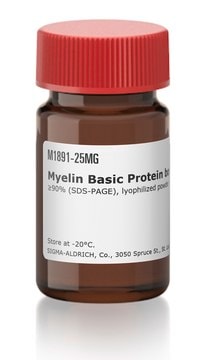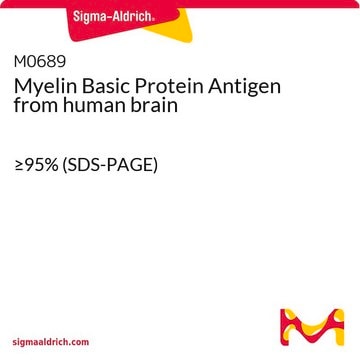Recommended Products
biological source
bovine
Quality Level
form
liquid
shelf life
2 yr
manufacturer/tradename
Upstate®
technique(s)
activity assay: suitable
solubility
water: soluble
NCBI accession no.
UniProt accession no.
shipped in
wet ice
storage temp.
−20°C
Gene Information
bovine ... MBP(618684)
General description
Research Area: Cell Signaling
Myelin basic protein (MBP) constitutes approximately 30% of the total protein and accounts for about 10% of the dry weight of myelin. It is primarily associated with the cytosolic side of the oligodendrocyte (OL) membrane, largely through electrostatic interactions with acidic lipids. This protein is distributed throughout compact internodal myelin. MBP consists of multiple post-translationally modified isomers with varying charges, some of which arise from phosphorylation at several sites by different kinases, including mitogen-activated protein kinase (MAPK).
Myelin basic protein (MBP) constitutes approximately 30% of the total protein and accounts for about 10% of the dry weight of myelin. It is primarily associated with the cytosolic side of the oligodendrocyte (OL) membrane, largely through electrostatic interactions with acidic lipids. This protein is distributed throughout compact internodal myelin. MBP consists of multiple post-translationally modified isomers with varying charges, some of which arise from phosphorylation at several sites by different kinases, including mitogen-activated protein kinase (MAPK).
Application
Myelin basic protein purified from bovine brain and de-phosphorylated using Lambda protein phosphatase. No detectable endogenous phosphorylation as determined by immunoblotting 1 microgram of MBP with 1 microgram/ml anti phospho MBP.
Biochem/physiol Actions
Myelin basic protein (MBP) is distributed throughout compact internodal myelin. It binds to negatively charged lipids on the cytosolic surface of oligodendrocyte membranes, likely facilitating the adhesion of these surfaces in the multilayered myelin sheath. MBP is characterized as an intrinsically unstructured protein, providing it with the flexibility to bind to a charged surface along its entire length and adapt its local conformation as needed to optimize binding to various targets. Such proteins often function as multifunctional regulatory proteins.
MBP interacts with polyanions such as actin filaments and microtubules in vitro and binds to other ligands such as Ca2+-calmodulin (CaM). MBP binds to G-actin, inducing its polymerization, and it bundles actin filaments. It also polymerizes actin, bundles F-actin filaments, and binds actin filaments to lipid bilayers through electrostatic interactions. Phosphorylation and dephosphorylation of MBP occur in the myelin sheath in response to electrical activity in the brain.
MBP interacts with polyanions such as actin filaments and microtubules in vitro and binds to other ligands such as Ca2+-calmodulin (CaM). MBP binds to G-actin, inducing its polymerization, and it bundles actin filaments. It also polymerizes actin, bundles F-actin filaments, and binds actin filaments to lipid bilayers through electrostatic interactions. Phosphorylation and dephosphorylation of MBP occur in the myelin sheath in response to electrical activity in the brain.
Quality
routinely evaluated as a substrate in a kinase assay using MAP Kinase 2/Erk2 (Catalog # 14-173)
Physical form
10mM MOPS, pH 7.0, 128mM MnCl2, 641mM EDTA, 1.134μg inactive lambda phosphatase and 0.05% sodium azide
Storage and Stability
2 years at -20°C
Other Notes
This product is derived from bovine source. Export of this product to certain countries may be restricted. Please contact Customer Service or your local distributor to inquire about product availability and export options.
Legal Information
UPSTATE is a registered trademark of Merck KGaA, Darmstadt, Germany
Disclaimer
Unless otherwise stated in our catalog or other company documentation accompanying the product(s), our products are intended for research use only and are not to be used for any other purpose, which includes but is not limited to, unauthorized commercial uses, in vitro diagnostic uses, ex vivo or in vivo therapeutic uses or any type of consumption or application to humans or animals.
Storage Class
12 - Non Combustible Liquids
wgk_germany
WGK 2
flash_point_f
Not applicable
flash_point_c
Not applicable
Certificates of Analysis (COA)
Search for Certificates of Analysis (COA) by entering the products Lot/Batch Number. Lot and Batch Numbers can be found on a product’s label following the words ‘Lot’ or ‘Batch’.
Already Own This Product?
Find documentation for the products that you have recently purchased in the Document Library.
J W Crabb et al.
Protein science : a publication of the Protein Society, 7(3), 746-757 (1998-04-16)
Cellular retinaldehyde-binding protein (CRALBP) is abundant in the retinal pigment epithelium (RPE) and Müller cells of the retina where it is thought to function in retinoid metabolism and visual pigment regeneration. The protein carries 11-cis-retinal and/or 11-cis-retinol as endogenous ligands
Gaëlle Lentini et al.
Nature communications, 12(1), 3788-3788 (2021-06-20)
Active host cell invasion by the obligate intracellular apicomplexan parasites relies on the formation of a moving junction, which connects parasite and host cell plasma membranes during entry. Invading Toxoplasma gondii tachyzoites secrete their rhoptry content and insert a complex
Thrombospondin stimulates focal adhesion disassembly through Gi- and phosphoinositide 3-kinase-dependent ERK activation
Orr, A. W., et al
The Journal of Biological Chemistry, 277, 20453-20460 (2002)
Dario Hermida et al.
Molecular & cellular proteomics : MCP, 19(2), 326-343 (2019-12-20)
The human MASTL (Microtubule-associated serine/threonine kinase-like) gene encodes an essential protein in the cell cycle. MASTL is a key factor preventing early dephosphorylation of M-phase targets of Cdk1/CycB. Little is known about the mechanism of MASTL activation and regulation. MASTL
Effect of phosphorylation of myelin basic protein by MAPK on its interactions with actin and actin binding to a lipid membrane in vitro
Boggs JM, et al.
Biochemistry, 45(2), 391-401 (2006)
Articles
Analytical Enzyme Chymotrypsin: Chymotrypsin is produced in the acinar cells of the pancreas as the inactive precursor, chymotrypsinogen.
Our team of scientists has experience in all areas of research including Life Science, Material Science, Chemical Synthesis, Chromatography, Analytical and many others.
Contact Technical Service






